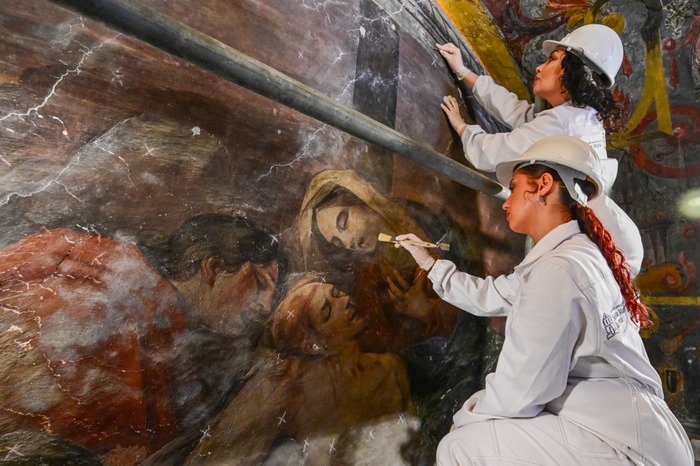Throats warm up, bows dance and a few strings vibrate in the depths of the Louvre.
On stage, thirty-two musicians, violins, a theorbo, a bassoon and a beautiful fifteen voices agree to the smallest movements of the conductor.
Perched on a swivel chair, sleeves rolled up, pen in hand, Sébastien Daucé distributes his instructions like a commander on the deck of his ship:
“More muscular!
More flexible !
More regal!
Clearer, these first three quavers;
watch out, it's too quiet on the left!
We have to say to ourselves “what presence, what brilliance, what beauty!”»
An incomparable Baroque flavor of the 1660s-1680s emanates from the refrains and sacred accents that leap between the stone walls of the auditorium.
But the instruments do not betray what the singing reveals: the repeated work is English.
Four centuries before Gustav Holst and Benjamin Britten, a brilliant generation of composers from across the Channel created an extraordinary musical abundance in England for a time.
It was at the beginning of the Stuart Restoration, in the early years of Charles II's reign, after the chaos and wars of the English Revolution.
Aside from Henry Purcell, the late superstar of the lot, these early geniuses of English Baroque have passed into oblivion.
It was without counting on the excitement of a music lover.
Read alsoThe British Museum is about to conclude “a major agreement” on the return of the Parthenon friezes
"All those who immediately preceded Purcell are unknown today",
regrets Sébastien Daucé, founder and artistic director of the Correspondances ensemble, specializing in French music of the 17th century.
The conductor behind the superb resurrection of the Ballet Royal de la Nuit has endeavored to bring this forgotten musical heritage back to light.
“There is Pelham Humphrey, a flamboyant virtuoso, who died in 1674, aged just 27, like cursed rockstars;
Matthew Locke, a glory of his time;
and later
John Blow
, who was also very creative”,
he lists, with a smile on his face.
Louis XIV (on the left, painted by Charles Le Brun in 1661) welcomed the King of England Charles II (on the right, painted by John Michael Wright around 1660-1665) in Saint-Germain-en-Laye for several years, the time of his exile on the continent.
Bridgeman Images/Wikimedia Commons
Under the direction of Sébastien Daucé, the Correspondances ensemble has worked on a panorama of these English artists – associated with their French contemporaries Pierre Robert and Henry Du Mont – in a new program,
Au service de Sa Majesté
, the first of which was presented in October at the Ambronay festival.
Three months later, he returns to the Louvre to host the second concert - given on Friday January 6 in its auditorium.
Almost a homecoming for Pelham Humfrey and his peers, who owe so much to French influence.
Read alsoAndrás Schiff, in the service of Bach
London Calling
Driven out by the revolution and then the establishment of the Republic of Cromwell, the English royal family in exile made a long stay in France.
Louis XIV installed it until 1654 in the castle of Saint-Germain-en-Laye.
Leading a festive life on the continent, the future Charles II witnessed the first reforms of the Sun King and took a liking to the new emerging musical spirit.
“Under Louis XIV, the Royal Chapel developed a French rite, known as Gallican, with the genre of grand motets, that is to say psalms set to music, instead of the sung office.
It is much less austere than a traditional mass!
, explains Sébastien Daucé.
And when Charles II returned to his throne in the 1660s, he copied Louis XIV's project in London.
He reorganized his royal chapel and recruited new talents
.
It's as if we had forgotten all about Racine in France and that an English troupe was preparing a performance!
Sebastien Dauce
The restored Royal Court thus undertook to move away from the polyphonies of the English Renaissance and to draw inspiration, rather, from the great musical pieces then fashionable in France thanks to the compositions of Henry Du Mont and then Lully.
The local variant of the grand motet is dubbed the "
symphony anthem"
.
Sébastien Daucé became fascinated by the network of influence and inspiration that is woven at this key moment.
“Charles II first collaborated with Matthew Locke, a composer who had long remained loyal to him and to whom he entrusted the music for his coronation
, he says.
As for Pelham Humphrey, his gifted eldest, whom the king sent, at the age of 17, to train at the court of France, with Lully.
He imprints a French color on his typically English writing which will greatly influence Purcell a few years later.
Read alsoMarine Chagnon, a mezzo in full light
A sign of the confidentiality of this repertoire, several of the British artists in the ensemble had never heard of Pelham Humphrey.
Others are familiar with it… but from afar.
“I knew him by name, but I had never had the opportunity to interpret his works until then
,” says countertenor Lewis Hammond.
His colleague, the tenor Oscar Golden-Lee, agrees:
"These are pieces that have never been played, it's really rare to be able to hear them to the public today".
"The crowning glory is that these works were not lost and were the subject of a major publication in the 1960s",
remarks Sébastien Daucé, amused to be the one who, from France, works at bring these virtuosos of yesteryear back to life.
He himself rediscovered these creations only by drawing the thread of French influence from English composers of the 17th century.
“It's as if we had forgotten everything about
Racine
in France and that an English troupe was preparing a performance!”
he jokes.
The sublime Albion of the 17th century and its court hymns can tip their hats to French musical art.







/cloudfront-eu-central-1.images.arcpublishing.com/prisa/BRRQWHKHTBFDJJ6EREN2ZD5LLE.png)

/cloudfront-eu-central-1.images.arcpublishing.com/prisa/7REYEUK6IVDWNO3WIR4VSHAVWQ.jpg)